Department of Mayotte
Département de Mayotte
| |
|---|---|

Sunset in Mamoudzou, Mayotte
| |
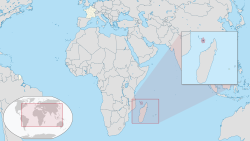 | |
| Coordinates: 12°50′35″S 45°08′18″ECoordinates: 12°50′35″S 45°08′18″E | |
| Country | |
| Prefecture | Mamoudzou |
| Departments | 1 |
| Government | |
| • President of Regional Councillors | Soibahadine Ibrahim Ramadani |
| Area | |
| • Total | 374 km2 (144 sq mi) |
| Area rank | 18th region |
| Population
(Jan. 2019)[1]
| |
| • Total | 270,372 |
| • Density | 720/km2 (1,900/sq mi) |
| Demonym(s) | Maorais |
| Time zone | UTC+03:00 (EAT) |
| ISO 3166 code | FR-YT |
| GDP (2017)[2] | Ranked 18th |
| Total | €2.9 billion (US$3.3 bn) |
| Per capita | €11,354 (US$12,820) |
| NUTS Region | FRA |
| Website | Prefecture Departmental Council |
Mayotte (French: Mayotte, pronounced [majɔt]; Shimaore: Maore, IPA: [maˈore]; Malagasy: Mahori) is an overseas department and region of France officially named the Department of Mayotte (French: Département de Mayotte).[3] It consists of a main island, Grande-Terre (or Maore), a smaller island, Petite-Terre (or Pamanzi), and several islets around these two. Mayotte is part of the Comoros archipelago, located in the northern Mozambique Channel in the Indian Ocean off the coast of Southeast Africa, between northwestern Madagascar and northeastern Mozambique. The department status of Mayotte is recent and the region remains, by a significant margin, the poorest in France. Mayotte is nevertheless much more prosperous than the other countries of the Mozambique Channel, making it a major destination for illegal immigration.
Mayotte's area is 374 square kilometres (144 sq mi) and, with its 270,372 people according to January 2019 official estimates,[1] is very densely populated at 723 per km2 (1,872 per sq mi). The biggest city and prefecture is Mamoudzou on Grande-Terre. However, the Dzaoudzi–Pamandzi International Airport is located on the neighbouring island of Petite-Terre. The territory is also known as Maore, the native name of its main island, especially by advocates of its inclusion in the Union of the Comoros.
Although, as a department, Mayotte is now an integral part of France, the majority of the inhabitants do not speak French as a first language,[4] but a majority of the people 14 years and older report in the census that they can speak French (with varying levels of fluency).[5] The language of the majority is Shimaore, a Sabaki language closely related to the varieties in the neighbouring Comoros islands. The second most widely spoken native language is Kibushi, a Malagasy language, of which there are two varieties, Kibushi Kisakalava, most closely related to the Sakalava dialect of Malagasy, and Kibushi Kiantalaotra. Both have been influenced by Shimaore. The vast majority of the population is Muslim.
The island was populated from neighbouring East Africa with later arrival of Arabs, who brought Islam. A sultanate was established in 1500. In the 19th century, Mayotte was conquered by Andriantsoly, former king of Iboina on Madagascar, and later by the neighbouring islands Mohéli and then Anjouan before being purchased by France in 1841. The people of Mayotte voted to remain politically a part of France in the 1974 referendum on the independence of the Comoros. Mayotte became an overseas department on 31 March 2011 and became an outermost region of the European Union on 1 January 2014, following a 2009 referendum with an overwhelming result in favour of the department status.
The new department is facing enormous problems and challenges: in 2019, with an annual population growth of 3.8%, half the population is less than 17 years old, unemployment reaches 35% and 84% of the inhabitants live below the official poverty line. In addition, as a result of massive illegal immigration from neighboring islands, 48% of the population are foreign nationals.[6]
Contents
Geography[edit]
The term Mayotte (or Maore) may refer to all of the department's islands, of which the largest is known as Maore (French: Grande-Terre) and includes Maore's surrounding islands, most notably Pamanzi (French: Petite-Terre), or only to the largest island. The name is believed to come from Mawuti, contraction of the Arabic جزيرة الموت Jazīrat al-Mawt – meaning "island of death" (maybe due to the dangerous reefs circling the island) and corrupted to Mayotta in Portuguese, later turned into French. However, the local name is Mahore, and the Arabic etymology is doubtful.
The main island, Grande-Terre (or Maore), geologically the oldest of the Comoro Islands, is 39 kilometres (24 mi) long and 22 kilometres (14 mi) wide, and its highest point is Mount Benara, at 660 metres (2,165 ft) above sea level. Because of the volcanic rock, the soil is relatively rich in some areas. A coral reef encircling much of the island ensures protection for ships and a habitat for fish. Dzaoudzi was the capital of Mayotte (and earlier the capital of all the colonial Comoros) until 1977, when the capital was relocated to Mamoudzou on the main island of Grande-Terre. It is situated on Petite-Terre (or Pamanzi), which at 10 square kilometres (4 sq mi) is the largest of several islets adjacent to Maore. The area of the lagoon behind the reef is approximately 1,500 square kilometres (580 sq mi), reaching a maximum depth of about 80m. It is described as "the largest barrier-reef-lagoon complex within the southwestern Indian Ocean".[7]
Environment[edit]
Geology[edit]
Mayotte is a primarily volcanic island rising steeply from the bed of the ocean to a height of 660 metres (2,170 ft) on Mont Bénara (Open Street Map gives this as 661 metres (2,169 ft)).
Two volcanic centres are reported, a southern one (Pic Chongui, 594 metres (1,949 ft), with a breached crater to the NW, and a northern centre (Mont M'Tsapéré, 572 metres (1,877 ft)) with a breached crater to the south-east. Mont Bénara is on the curving ridge between these two peaks, approximately at the contact point of the two structures. Volcanic activity started about 7.7 million years ago in the south, ceasing about 2.7 million years ago. In the north, activity started about 4.7 million years ago and lasted until about 1.4 million years ago. Both centres had several phases of activity.[8] The most recent age reported for an ash band is 7000 year BP.[7]
Earthquake Swarm[edit]
The November 11, 2018, seismic event occurred about 15 miles (24 km) off the coast of Mayotte. It was recorded by seismograms in many places, including Kenya, Chile, New Zealand, Canada, and Hawaii located almost 11,000 miles (18,000 km) away.[9] The seismic waves lasted for over 20 minutes but despite this, no one felt it.[10][9]
The earthquake swarm has subsequently been linked to a newly discovered undersea volcano located 50 km away from Mayotte at a depth of 3500m.[11]
Marine environment[edit]
Mayotte is surrounded by a typical tropical coral reef. It consists in a large outer barrier reef, enclosing one of the world's largest and deepest lagoons, followed by a fringing reef, interrupted by many mangroves. All Mayotte waters are ruled by a National marine Park, and many places are natural reserves.
The outer coral reef is 195 km long, housing 1,500 km2 of lagoon, including 7.3 km2 of mangrove. There are at least 250 different species of coral, 760 tropical fish species, and the National Natural Heritage Inventory (INPN) has no fewer than 3,616 marine species, but this is probably a far cry from the actual count. As this region of the world is still poorly inventoried by scientists, the waters of Mayotte continue to harbour many unknown species of science, and allow important scientific discoveries each year.[12]
Terrestrial environment[edit]
Mayotte has a great diversity in its plant life: more than 1,300 species are recorded, half of them being endemic, making this island one of the richest in the world compared to its size.[13] 15% of the island is classified as natural reserve; however, the primal forest now covers barely 5% of the island due to illegal deforestation.
Just like many volcanic islands, Mayotte shelters quite a limited mammal biodiversity, the only native species being flying foxes (Pteropus seychellensis comorensis). However, there are 18 species of reptiles, 23 of terrestrial mollusks, 116 butterflies, 38 dragonflies, 50 grasshoppers, 150 beetles.[13]
History[edit]
In 1500, the Maore sultanate was established on the island. In 1503, Mayotte was observed and named (firstly Espiritu Santu) by Portuguese explorers, but not colonized. The island has known several eras of wealth (especially during the 11th century at Acoua or between 9th and 12th centuries at Dembéni), being an important part of the swahili coast culture. However, its sister island Anjouan was preferred by international traders due to its better suitability to large boats, and for a long time Mayotte remained poorly developed compared to the three other Comoros islands, and often targeted by pirates and Malagasy or Comorian raids.
In 1832, Mayotte was conquered by Andriantsoly, former king of Iboina on Madagascar; in 1833, it was conquered by the neighbouring sultanate of Mwali (Mohéli island in French). On 19 November 1835, Mayotte was again conquered by the Ndzuwani Sultanate (Anjouan sultanate in French); a governor was installed with the unusual Islamic style of Qadi (from the Arabic قاض which means judge). However, in 1836 it regained its independence under a last local Sultan. Andriantsoly won again the island in 1836, but his depopulated and unfortified island was in a weak position towards the sultans of Comoros, Malagasy kings and pirates. Looking for the help of a powerful ally, he began to negotiate with the French, installed in the nearby Malagasy island of Nosy Bé in 1840.
Mayotte was purchased by France in 1841, and integrated to the Crown. This also entailed the end of the slavery regime which had dominated the island for centuries : the slaves were sent free and most of the masters, ruined, had to leave the island.
Mayotte therefore becomes a French island, but it remains above all an island emptied of its inhabitants by decades of wars, as well as by the exodus of former elites and part of their slaves: most of the cities are abandoned, and nature has regained its rights over the old plantations. The French administration therefore tries to repopulate the island, recalling first of all the Mayotte exiles or refugees in the region (Comoros, Madagascar), proposing to the former exiled masters to return in exchange for compensation, then by inviting wealthy Anjouan families to come and set up trade. France launches some first major works, such as the realization in 1848 of the Boulevard des Crabes connecting the rock of Dzaoudzi to Pamandzi and the rest of Petite-Terre.
In the wake of the West Indies and Reunion, the French government plans to make Mayotte a sugar island: despite the steep slopes, large plantations are being developed, 17 sugar factories were built and hundreds of foreign workers (mainly African, in particular Mozambic Makwas) were hired from 1851 onwards. However, production remained mediocre, and the sugar crisis of 1883-1885 quickly led to the end of this crop in Mayotte (which had just reached its peak of production), leaving only a few factory ruins, some of which are still visible now. The last sugar plant to be closed was Dzoumogné in 1955: the best preserved, and now heritage, is Soulou, in the west of the island.
At the Berlin conference in 1885, France takes control over the whole Comoros archipelago, which was actually already ruled by French traders : the colony takes the name of "Mayotte and dependencies".
In 1898, two cyclones raze the island to the ground, and a smallpox epidemic decimates the survivors. Mayotte has to start from the beginning once again, and the French government has to repopulate the island with workers from Mozambique, Comoros and Madagascar. The sugar industry is abandoned, replaced by vanilla, coffee, copra, sisal, then fragrant plants such as vetiver, citronelle, sandalwood and especially ylang-ylang, which will later become one of the symbols of the island.
Mayotte was the only island in the archipelago that voted in referenda in 1974 and 1976 to retain its link with France and forgo independence (with 63.8% and 99.4% of votes respectively). The United Nations' constant policy regarding decolonisation has been that independence must be effected in the framework of the colonial borders and for that reason it has not recognized the validity of that referendum; over twenty UN resolutions have condemned France's annexation of Mayotte, while the independent Comoros have never ceased to claim the island.[14] A draft 1976 United Nations Security Council resolution recognizing Comorian sovereignty over Mayotte, supported by 11 of the 15 members of the Council, was vetoed by France.[15] It was the last time, as of 2011, that France cast a lone veto in the Council.[16] The United Nations General Assembly adopted a series of resolutions on the issues, under the title "Question of the Comorian Island of Mayotte" up to 1995. Since 1995, the subject of Mayotte has not been discussed by the General Assembly, and all the following referenda over Mayotte independence have shown a strong will of Mayotte people to remain French.
Mayotte became an overseas department of France in March 2011 in consequence of a 29 March 2009 referendum.[17] The outcome was a 95.5 per cent vote in favour of changing the island's status from a French "overseas community" to become France's 101st département.[18] Its non-official traditional Islamic law, applied in some aspects of the day-to-day life, will be gradually abolished and replaced by the uniform French civil code.[19] Additionally, French social welfare and taxes apply in Mayotte, though some of each will be brought in gradually.[20] Comoros continues to claim the island, while criticising the French military base there.[21]
Politics[edit]
The politics of Mayotte takes place in a framework of a parliamentary representative democratic government and of a multi-party system, whereby the President of the Departmental Council is the head of the local assembly. Executive power is exercised by the French government.
Mayotte also sends one deputy to the French National Assembly and two senators to the French Senate.
Unlike the other overseas regions and departments of France, Mayotte possesses a single local assembly, officially called the "departmental council" (conseil départemental), which acts both as a regional and departmental council.
The situation of Mayotte proved to be awkward for France: while the local population very largely did not want to be independent from France and join the Comoros, some post-colonial leftist governments voiced criticism of Mayotte's ongoing ties to France.[citation needed] Furthermore, the peculiar local administration of Mayotte, largely ruled by customary Muslim law, would be difficult to integrate into the legal structures of France, not to mention the costs of bringing the standards of living to levels close to those of Metropolitan France. For these reasons, the laws passed by the national parliament had to state specifically that they applied to Mayotte for them to be applicable on Mayotte.
The status of Mayotte was changed in 2001 towards one very close to the status of the departments of France, with the particular designation of departmental collectivity. This change was approved by 73% of voters in a referendum. After the constitutional reform of 2003 it became an overseas collectivity while retaining the title "departmental collectivity" of Mayotte.
Mayotte became an overseas department of France (département d'outre-mer, DOM) on 31 March 2011 following the result of the March 2009 Mahoran status referendum, which was overwhelmingly approved by around 95% of voters.[23][24] Becoming an overseas department will mean it will adopt the same legal and social system as used in the rest of France. This will require abandoning some customary laws, adopting the standard French civil code, and reforming the judiciary, educational, social and fiscal systems, and will take place over a period of about 20 years.[25]
Despite its domestic constitutional evolution from the status of an overseas collectivity to that of an overseas department, effectively becoming a full constituent territory within the French Republic, with regards to the European Union, Mayotte remained an 'overseas country and territory' (OCT) in association with the Union (as per Article 355(2) TFEU) and not a constituent territory of the European Union in the same way as the other four overseas departments. However following a directive of the European Council in December 2013, Mayotte became an outermost region of the European Union on 1 January 2014.[26] This successful agreement between the 27 member states follows a petition made by the French government for Mayotte to become an integral territory of the European Union nonetheless benefiting from the derogation clause applicable in existing outermost regions, namely Article 349 TFEU, as favoured in a June 2012 European Commission opinion on Mayotte's European constitutional status.[27]
Administrative divisions[edit]
Mayotte is divided into 17 communes. There are also 13 cantons (not shown here). There are no arrondissements.
Transport[edit]
- Waterways
- Highways:
- Total: 93 kilometres (58 mi)
- Paved: 72 kilometres (45 mi)
- Unpaved: 21 kilometres (13 mi)
- Total: 93 kilometres (58 mi)
- Ports and harbours:
- Dzaoudzi
- "Longoni" (Koungou)
- Airport: Dzaoudzi Pamandzi International Airport
- With paved runways: 1 (2002)
Economy[edit]
In 2017, the GDP of Mayotte at market exchange rates was €2.9 billion (US $3.3 bn).[2] In that same year the GDP per capita of Mayotte at market exchange rates, not at PPP, was €11,354 (US $12,820),[2] which was 16 times larger than the GDP per capita of the Comoros that year, but only 49.5% of the GDP per capita of Réunion and 33% of the GDP per capita of Metropolitan France.
The local agriculture is threatened by insecurity, and due to a more expensive workforce can't compete on the export ground with Madagascar or the Comoros union. The major economic potential of the island remains tourism, however hampered by delinquency rates.
Demographics[edit]
| Population census | ||
|---|---|---|
| Year | Pop. | ±% p.a. |
| 1958 | 23,364 | — |
| 1966 | 32,607 | +4.25% |
| 1978 | 47,246 | +3.14% |
| 1985 | 67,205 | +5.16% |
| 1991 | 94,410 | +5.83% |
| 1997 | 131,320 | +5.65% |
| 2002 | 160,265 | +4.06% |
| 2007 | 186,452 | +3.07% |
| 2012 | 212,645 | +2.66% |
| 2017 | 256,518 | +3.82% |
| 2019 | 270,372 | — |
| Official population figures from past censuses.[29] Last INSEE estimate in italic.[1] | ||
On January 1, 2019, a record 270,372 people were living in Mayotte (official INSEE estimate).[1] According to the 2017 census, 58.5% of the people living in Mayotte were born in Mayotte (down from 63.5% at the 2007 census), 5.6% were born in the rest of the French Republic (either metropolitan France or overseas France except Mayotte) (up from 4.8% in 2007), and 35.8% were immigrants born in foreign countries (up from 31.7% at the 2007 census, with the following countries of birth in 2007: 28.3% born in the Union of the Comoros, 2.6% in Madagascar, and the remaining 0.8% in other countries).[30][31]
Most of the inhabitants of the island are culturally Comorians. The Comorians are a blend of settlers from many areas: Iranian traders, mainland Africans, Arabs and Malagasy. Comorian communities can also be found in other parts of the Comoros chain as well as in Madagascar.
Due to large inflows of immigrants from the Union of the Comoros, the native Mahorans have now become a minority on the island among the adult population. At the 2017 census, the people born in Mayotte made up only 39.9% of the adult population, while the people born in foreign countries (predominantly the Union of the Comoros) made up 54.6% of the adult population.[32] In 2017, the mothers born in foreign countries (predominantly the Union of the Comoros) were responsible for 75.7% of the births that took place in Mayotte.[33]
Religions[edit]
The main religious minority, Roman Catholicism, has no proper diocese but is served, together with the Comoros, by a missionary jurisdiction, the Apostolic Vicariate of Comoros Archipelago.
Languages[edit]
French is the only official language of Mayotte. It is the language used for administration and the school system. It is the language most used on television and radio as well as in commercial announcements and billboards. In spite of this, knowledge of French in Mayotte is lower than in any other part of France. The native languages of Mayotte are:
- Shimaore, a dialect of the Comorian language (a close relative of Swahili)
- Kibushi, a western dialect of the Malagasy language (the language of Madagascar) heavily influenced by Shimaore and Arabic
- Kiantalaotsi, another western dialect of the Malagasy language also heavily influenced by Shimaore and Arabic
Kibushi is spoken in the south and north-west of Mayotte, while Shimaore is spoken elsewhere.
Besides French, other non-indigenous languages are also present in Mayotte:
- Arabic, essentially learned in the Quranic schools
- various non-Shimaore dialects of the Comorian language, essentially imported by immigrants who have arrived in Mayotte since 1974: Shindzwani (the dialect of Anjouan, or Nzwani), Shingazidja (the dialect of Grande Comore, or Ngazidja), and Shimwali (the dialect of Mohéli, or Mwali).
Shingazidja and Shimwali on the one hand and Shimaore on the other hand are generally not mutually intelligible. Shindzwani and Shimaore are perfectly mutually intelligible.
2012 and 2017 censuses[edit]
No questions regarding the knowledge and/or use of languages were asked in the 2012 and 2017 censuses, and no question relative to languages will be asked in the future censuses of Mayotte, leaving the now quite outdated census data from 2007 as the last official data on the topic of languages. Improvement in schooling has markedly increased French literacy and knowledge since 2007.
2007 census[edit]
At the 2007 census, 63.2% of people 14 years and older reported that they could speak French, with large differences with age. 87.1% of those whose age was 14 to 19 years old reported that they could speak it, whereas only 19.6% of those aged 65 and older reported that they could speak it. 93.8% of the population whose age was 14 or older reported that they could speak one of the local languages of Mayotte (Shimaore, Kibushi, Kiantalaotsi, or any of the Comorian dialects, which the census included in the 'local languages'). 6.2% of the population aged 14 and older reported that they spoke none of the local languages and could speak only French.[5]
2006 survey[edit]
A survey was conducted by the French Ministry of National Education in 2006 among pupils registered in CM2 (equivalent to fifth grade in the US and Year 6 in England and Wales). Questions were asked regarding the languages spoken by the pupils as well as the languages spoken by their parents. According to the survey, the ranking of mother tongues was the following (ranked by number of first language speakers in the total population; note that percentages add up to more than 100% because some people are natively bilingual):[36]
- Shimaore: 55.1%
- Shindzwani: 22.3%
- Kibushi: 13.6%
- Shingazidja: 7.9%
- French: 1.4%
- Shimwali: 0.8%
- Arabic: 0.4%
- Kiantalaotsi: 0.2%
- Other: 0.4%
When also counting second language speakers (e.g. someone whose mother tongue is Shimaore but who also speaks French as a second language) then the ranking became:
- Shimaore: 88.3%
- French: 56.9%
- Shindzwani: 35.2%
- Kibushi: 28.8%
- Shingazidja: 13.9%
- Arabic: 10.8%
- Shimwali: 2.6%
- Kiantalaotsi: 0.9%
- Other: 1.2%
With the mandatory schooling of children and the economic development both implemented by the French central state, the French language has progressed significantly on Mayotte in recent years. The survey conducted by the Ministry of National Education showed that while first and second language speakers of French represented 56.9% of the population in general, this figure was only 37.7% for the parents of CM2 pupils, but reached 97.0% for the CM2 pupils themselves (whose age is between 10 and 14 in general).
Nowadays there are instances of families speaking only French to their children in the hope of helping their social advancement. With French schooling and French-language television, many young people turn to French or use many French words when speaking Shimaore and Kibushi, leading some to fear that these native languages of Mayotte could either disappear or become some sort of French-based creole.[37]




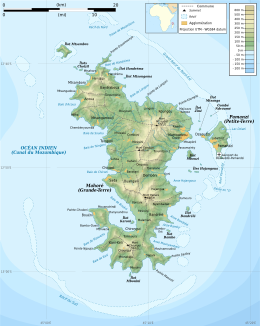



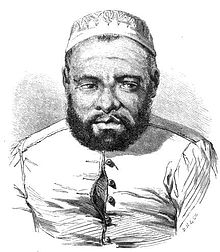

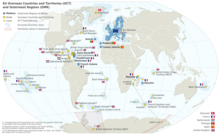
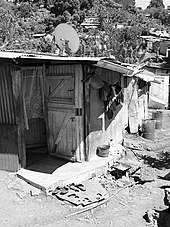

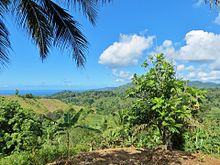
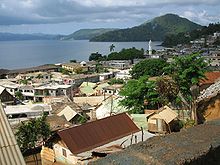
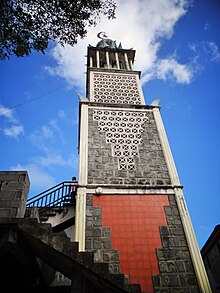
Nenhum comentário:
Postar um comentário